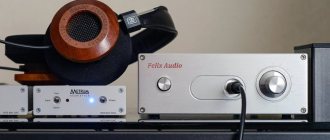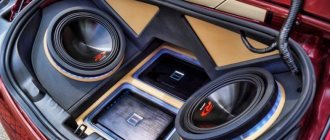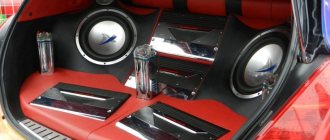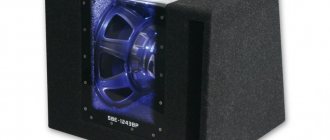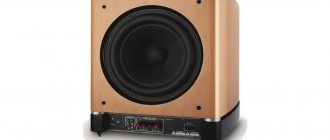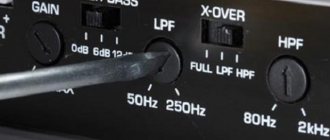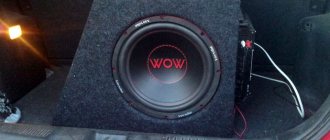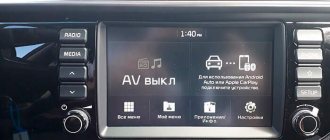What is Car Audio and how to properly build an audio system in your car?
It is very difficult to find a car today that does not have music playing in the cabin. And this is absolutely understandable, because it is very pleasant to be in the car to the rhythms of your favorite songs, especially with high-quality sound. Good sound makes the trip unforgettable not only for the driver, but also for the passengers of the vehicle. But what is “Auto Sound” and, as they say, “what do you eat it with”?
Car audio is not just music, it is a very complex concept. It represents a whole science about the characteristics of components, structure and composition of an audio system; one of the sections of auto tuning. This discipline has its own specific requirements and rules: for the selection of components, the correct construction of a music playback system and its installation. The accuracy and clarity of the sound of melodies directly depends on the correct selection of components of the audio complex. Previously, only a few car enthusiasts - fanatics - were interested in car Audio. Now, this modern entertainment has touched the hearts of many. Every year more and more people become interested in this area, new products appear in the auto audio industry. Long gone are the days when the limit of good sound in a car was considered to be a set of “Branded Radio with two Standard Speakers”. Nowadays this will surprise few people, and modern drivers usually equip their audio system themselves to achieve the optimal sound quality for them.
So, what parts does a car audio system consist of?
Modern car audio can have several components, including: * radio, * acoustics, * subwoofer, * sound processor. * amplifier.
This can all be in different combinations, with the presence of some components and the absence of other components, or with the simultaneous installation of all.
The car radio acts as the head unit, since without it it is a priori impossible to imagine car audio as a whole. It is she who reads information from the media and displays it on the car’s acoustics.
An acoustic system is the second prerequisite for car audio. Installed to output sound from a car radio. There are two main types of acoustic systems: component (low-, mid- and high-frequency speakers are installed separately), coaxial (speakers of different frequencies are assembled as one unit. Component speakers provide better sound quality compared to coaxial ones, but their cost is usually much more expensive.
The next component of car audio is the sound processor. It is optional and is installed on fairly high-level systems. Used to correct the negative impact of asymmetry and insufficient interior volume on the quality of music playback in a car.
It is difficult to imagine modern audio without an amplifier. It significantly improves natural sound quality even during quiet listening at low frequencies. This is due to a large number of built-in adjustments and filters that allow you to fine-tune the music playback in the car. It is not an integral part of the audio system in a car, but, nevertheless, the level of distortion of the additional amplifier is significantly lower compared to the amplifier built into the car radio.
The presence of a subwoofer adds pure bass to the background sound. This allows you to improve the acoustic design of the car, making the sound more voluminous and of higher quality. According to technical characteristics, a subwoofer is a separate speaker, larger than others in size, which has the ability to reproduce low frequencies. There are two types: active (with an amplifier) and passive (requires an additional amplifier. Installed in the rear of the cabin to prevent distortion of the front acoustics.
The process of creating a competent sound in a car is quite complex and consists of several stages.
The first stage determines the configuration of the future system, the combination of connected components.
The second stage involves thinking through the layout and number of speakers in the system. The most common speaker layouts are: “Front-rear”, “front-subwoofer”, “front-rear subwoofer”. The “Front to Rear” scheme is the most budget option; the speakers are responsible for the entire frequency range. “Front Subwoofer” is more expensive, but more harmonious. With the most complex “Front Rear Subwoofer” scheme, the rear speakers are isolated from the subwoofer so that its operation does not affect them.
The third stage is setup. Considering that it can consist of a large number of elements that work together, this is a very important process. Correct setting guarantees balanced sound, protects equipment from overload and makes it possible to obtain high-quality sound.
The fourth stage is design. It determines how your system will visually look. In this case, there are two approaches, diametrically different in appearance. The first is Stock, which preserves the car's interior as much as possible. The second is custom, where the components are exposed, which greatly changes the original appearance of the interior. However, it is necessary to understand that with a significant rearrangement of the audio system compared to the standard one, the interior of the cabin will change in any case.
To summarize, we can say that the sound in a car directly depends on the desire to get a high-quality system, diligence in selecting the necessary components and their installation, as well as on the sufficiency of time and funds allocated for all this.
We wish you good luck in building your own audio system, and may the sound of your car become sharper, bassier, piquant and more penetrating, delivering incredible pleasure when listening to your favorite music.
Focus on maximum power values
Yes, unfortunately, the radio does not have anywhere near the declared 50 watts per channel, but this is not a disaster, but simply the reality of the market, you just need to know this. Also, you will not get 1000 watts from amplifiers on the box of which such a number is brightly displayed with a proud postscript MAX. And usually, the larger and more colorful it is, the less truth there is in this information. But it must be said that this mainly concerns the budget segment.
Just when choosing,
focus on the power, which is indicated by RMS , and not on the maximum. Yes, RMS is not exactly long-term power (this is a topic for a separate article), but, nevertheless, it will be the most reliable guide for you. Read more about the selection of components in the article - How to choose an amplifier.
What is punch in car audio? Good punch: tips for car audio lovers
It is important to remember that the lower the signal frequency, the greater the volume of air that must be “pushed” through the speaker in order to obtain the same volume. This is why midrange drivers are larger than tweeters, midbass drivers are larger than midrange drivers, and subwoofers are larger than midwoofers.
The midbass range, which is precisely responsible for the punch, usually falls at the “junction” between the midbass and the subwoofer. And these are the difficulties that lie in wait here.
1. Strength of speaker mounting In classical systems, the midbass speaker is entirely responsible for the range of 100-200 Hz. It works in a fairly intense mode - since the diffuser is small, it has to move with a large amplitude. Accordingly, the speaker creates large loads on the base on which it is attached. Therefore, it is especially important to make durable and vibration-free podiums for the speakers. Insufficient rigidity is the cause of boominess, parasitic overtones and loss of sound energy. By the way, most often it is desirable to “cut” the speaker in frequency from below (60-90 Hz) in order to save it from trying to reproduce a signal that is too low-frequency. This significantly improves the sound at higher frequencies, including making the punch clearer.
2. Acoustic design This is especially important in “variety” systems. Most “pop” speakers are midrange speakers with a high resonant frequency. But even models with low Fs for the most part do not imply a large diffuser stroke. Therefore, with normal installation in a door, effective reproduction of such models begins at best from 250-300 Hz.
And here you can go down two paths. Firstly, select speakers with a low (for a “stage”) resonant frequency, but whose motors allow greater strokes than those of a typical “stage.” High sensitivity in such speakers is usually achieved by using more serious magnets.
The second option is to push the air not only with the speaker diffuser, but to connect to this process a bass reflex tuned (depending on the speaker) to a frequency of 100-120 Hz. In general, this is how many professional stage acoustic systems are built. In this case, you can select speakers with low Vas and low quality factor Qts. Bass-reflex acoustic design will significantly increase the output in the mid-bass range and allow you to get a real hard punch without any reservations.
3. “Energy”, “rate of fire” of the amplifier, load control. This is often forgotten, but in vain. The fact is that if the amplifier does not control the load well, this will lead to the fact that instead of a clear punch you will get an unpleasant buzz - the amplifier will “push” the diffuser, but it will not have enough control to “return” it back.
Investing your budget in one thing
A common mistake newbies make in car audio is investing most of their money in one component of the system.
For example, they often buy an expensive subwoofer or acoustics, but the radio, amplifiers, and perhaps the power supply do not meet this level. In this case, potential sound benefits are missed. Since ancient wisdom says: “The system plays only as well as its worst component.” In this case, it would be more advisable to purchase all components or a combination of approximately the same level , benefiting in overall sound quality.
Schemes for building car audio. Schemes for building car audio
Any normal business begins with planning. I think everyone will agree with this! After all, it is much easier to make a plan in advance and then implement its points than to try to do something without even understanding what, rushing from side to side-). Car audio is no exception.
The first thing you need to do is draw up a diagram for building an audio system in your car. Today, there are three main schemes for constructing sound in a car:
1. “Classical” - where the sound is played from the front, as if from the “stage”. 2. “Disco” or “club” - where the sound plays from all sides. 3. “Multimedia” - this is the same as in “home theater” systems, i.e. multi-channel surround sound system.
Now let's stop and look at the above schemes in more detail. Let's find out the pros and cons, so to speak!
Scheme No. 1 - “Classical”
In the caraudio world, such a scheme, where all the sound comes from the front (from the “stage”), is considered the most correct for both the sound and the listener. I’ll say right away that this is the only one used in car audio competitions. And for good reason! A person always tries to look towards the source of sound. When talking to an interlocutor, we look in his direction. At a concert or play, we also don’t sit with our backs to the stage, right? This is how our sense organs – vision and hearing – are structured and interconnected. Therefore, in a car it is quite natural to strive to get the sound “from the stage” as a result.
The “stage” is usually called the space in the area of the windshield above the dashboard of a car. In very good audio systems, the virtual space of the stage extends beyond the cabin, and the singer may well be singing on the edge of your hood! Achieving this is difficult, but possible.
Any normal business begins with planning. I think everyone will agree with this! After all, it is much easier to make a plan in advance and then implement its points than to try to do something without even understanding what, rushing from side to side-). Car audio is no exception.
So the “classic” scheme, as can be seen in the figure, is frontal (front) speakers plus a subwoofer. Here is the first problem! The fact is that a subwoofer (this is such a large box of 20-30 liters with a large woofer speaker, maybe someone else doesn’t know) is very problematic to place in the front part of the cabin, often the only place is the trunk. But what about the main principle of the “classical” scheme, where everything should play from the front, you ask? The fact is that the human ear is not able to localize (determine the location) frequencies below 130-150Hz. Here it is a “lifesaver”! Those. By placing the subwoofer in the trunk, with the correct settings and good front acoustics, we will clearly hear the bass from the front! I will focus on the front acoustics! Many people don’t pay attention to this at all, but the main spectrum (picture) of BASS is played by the FRONT SPEAKERS, and not the subwoofer. The subwoofer simply complements what the front is not able to play for physical reasons. I’ll tell you more about this in the following articles!
So far, today (I think in the near future) all the music we listen to is recorded in STEREO format. Those. only two channels (right and left). Recordings with multi-channel sound (like in films) are just beginning to appear. But their number is still insignificant. However, stereo recording allows us to create a “panoramic” sound using two different channels, where we can clearly determine where, say, this or that instrument or singer is located, i.e. determine the AIS (apparent sound source). This is the main goal of the “classical” circuit - creating clear, surround stereo sound.
There is one more problem. Unlike at home, where we can position ourselves at the same distance between two speakers, in a car we are always off-center. Therefore, sound from nearby speakers reaches us faster than from distant ones. Because of this, distortion and destruction of the stereo image occurs. However, there are several options to combat this problem. Starting from the location of the speakers, ending with the use of a DSP processor (time delay processor).
Scheme 2 - “Disco”
Until recently, and even now, many audio systems are built according to this scheme. Those. "front + rear". Moreover, often there is some kind of obscure acoustics 10-13 cm in front, but multi-band ovals (“pancakes”, 6”x9” speakers proudly lie behind). Or, in general, speakers in unlimited quantities are installed in all sorts of places in the car, according to the principle - wherever they fit. The result is sound from everywhere and nowhere. The advantage of such a system is ease of installation, the disadvantage is the lack of a “stereo image”, the inability to determine the location of the performer, etc. As a result, our poor brain, which is designed like this, trying at crazy speed to determine where the singer is singing, begins to “boil”! Well, he doesn’t understand why he (the singer) is rushing all over the salon!
This scheme has the right to life when listening to electronic music like “boom-boom”, or at car parties, where music is listened to near the car, and not in it! Also, with a powerful rear, it’s good to muffle the rear passengers (girls), because you (the driver) want BASS, and poor them, this speaker is screaming 10-20 cm from their ear! And when a subwoofer is added to the ovals, a “brain break” occurs -))) I’m sure that the phrase “make it quieter” from those sitting behind it was heard more than once!-) . I also often heard phrases like “I love the sound around me.” But excuse me, this is not “surround sound”, this is just a stereo recording where the front (front) two channels are simply duplicated to the rear. That's all! This is not a “quad” or a “home theater”! Have you ever seen speakers placed behind the audience at a concert? And the surround sound effect is achieved in completely different ways. To do this, a few low-power speakers are enough that will reproduce a piece of the midrange (read more in our KNOWLEDGE BASE, article “REAR QUESTIONS”).
Friends, use your brains and break stereotypes! Yes, yes, exactly the stereotypes that automakers imposed on us. I recommend re-reading “Scheme No. 1”. With the right approach, you can organize it for car parties! But besides this, you can listen to the right sound in the car!
Scheme 3 – Multimedia
As I wrote at the beginning of the article, this is a multi-channel sound system. What does this mean? This is when each channel (minimum 5.1) is recorded separately and carries its own (separate) sound information. This scheme comes from “home theater” systems, where a “presence effect” is created using sound. In cars, this scheme is gaining momentum mainly for those who like to watch movies in the car. There is also music in DTS (Digital Theater System) format. Perhaps the future lies with it, but so far it is very little widespread. “5.1” means: 5 channels (2 front, 2 rear, 1 center) plus 1 subwoofer channel.
Here we come to the end. Although it would be more correct to say... to the beginning of a long and interesting journey!
Buying a subwoofer without estimating free space
A common mistake is purchasing or choosing a subwoofer without first assessing the available space in the car. It happens that a subwoofer or subwoofers have already been purchased, and a good housing for them is not included in the car or in the space that can be allocated for it. The situation turns out to be a stalemate.
Therefore, be sure to first measure your free space , estimate the volume that you can allocate for a subwoofer, and based on this, choose the size and number of subwoofers. One important thing to remember is that in some sedans, the body that can fit freely in the trunk will not always fit through the trunk opening. This needs to be taken into account.
What is front in car audio?
Hello everyone) I decided to build a loud front in my new machine. I read a lot, watched and searched. And now the new midrange from Air Tone Audio, PRO-80 series, has arrived. Midrange diameter 20 cm, maximum power 400W, I also bought Kicx DTC 36 horn-type HF and Ural AK74.S speakers. Airtons with HF will eventually play through cross-overs with a bridge from the amplifier. I also bought a four-channel MYSTERY MK 4.80, yes, although it is a budget option, it is the best in its price category.
I also took an installation kit of wires, 4 kg of fiberglass mat (400) and 4 kg of polyester resin for future podiums that will be implanted into the door trims, as well as a brand new roller for removing air.
I removed the door trims and took measurements from the screens. I found sheets of plywood, and from them I began to cut out circles for the installation of dins. For each din, I cut out two sets of rings, some larger, others smaller, so that the speakers would be recessed inside. I cut out the rings and connected everything together. Under the horn I cut out one ring for each, since I thought that if they were not recessed, they would look more beautiful. For the 16th columns I took ready-made circles from old door trims. I installed it all on the casing using self-tapping screws and an aluminum profile for fastening.
When everything was installed and adjusted, I began to cover everything with tights, since I don’t know of any other material that stretches very well and has great tensile strength. He tightened it, gave it shape, and secured it. All that remains is to impregnate everything with polyester resin so that everything hardens, to further build up the layer and increase the strength of the structure. I diluted the required amount of resin with hardener, stirred, soaked, and left to dry until the next day.
Laying the glass mat on top of the “hardened tights”, I mixed the resin with the hardener and began to gradually saturate everything. Having soaked the fiber, he began to roll out the resin with a special roller, expelling air from the material (air is the enemy!). Having finished with all this work, and making sure that everything lay flat, he cleaned the tool from the resin and left the cards to dry.
After everything had hardened, I filled the excess voids with polyurethane foam, and again removed everything until it dried. I cut off the bulging excess with a knife. In the near future - there will be no time to mess around. Therefore, I decided to put everything in the car, so that the acoustics would play out and so that I could see how everything would roughly look.
As soon as I have time and finances, I’ll sand everything evenly and cover it with black eco-leather on a paralon backing. but this is getting closer to May)) for now I’m driving like this))) I hope I’ve outlined everything in detail and clearly to the delight of those reading)) I’m looking forward to your visit) New reports to the community are coming soon))
About processors
Processors are either built-in or external.
to contents
Built-in
GIs built into them are also so-called “full-fledged” and “inferior”.
to contents
Difference
The inferior one is different in that it does not have a crossover function. In this case, the tuning options are somewhat narrowed and requirements arise for amplifiers to have developed built-in crossovers. You should also pay attention to how many channels the processor built into the GU can control.
With the exception of only two GU models, all the others are capable of managing only six channels, that is, they are able to “settle” a two-way front (4 channels) and a subwoofer (2 channels).
to contents
Hybrid
However, there are also hybrid systems where six processor channels manage to control a three-way front and a subwoofer, but it will be necessary to add a crossover between the midrange and high-frequency drivers, and also think carefully about their relative position.
to contents
External
External processors, as a rule, all have a sufficient number of channels to control any stereo audio system. In addition, the big advantage of an external processor is that it can be placed close to the amplifiers, thereby reducing the length of interconnect wires, which is also beneficial for high-quality sound.
The audio source itself is connected to external processors. Ideally this should be a digital signal source. This could be a GU, a player, a smartphone. They communicate via fiber optic, coaxial wire, Wi-Fi or Bluetooth. Often external processors allow more than one input, that is, you can connect to them, for example, a standard GU and an iPhone. It is very important that the source is digital. Although you can connect an analog source to the processor, the sound quality will be lost due to unnecessary conversions. One last thing to know about processors.
Some of them (mostly older models) have the ability to be connected only to certain GIs and no others.
Modern processors are universal in connections.
They can be connected not only to specialized automotive PGs, but also to a computer, which is increasingly replacing conventional PGs. In the current situation, it is the use of a laptop computer that is seen as the most promising solution. The signal source for the processor can also be a telephone or a portable player.
to contents
What is Autosound?
Hey everyone!
Today there is a new question for readers :) Those who answered will receive a gift, but more on that towards the end of the post.
Car audio is a very broad topic. It unites people who listen to music in the car with completely different habits and preferences.
I respect such “gurus” as Kirill Dudkin, Sergei Sergeich, Karen Grigoryan, Sasha Pastukhov and many others. These are people who have been in car audio for many years, building champion cars, constantly participating in competitions... Their opinion basically boils down to the fact that everything that is a compromise and cheap is too far from the absolute. That you can’t use half measures, that you need to initially build a system of the highest quality possible. I completely respect and support this opinion... But!
My practice of communicating with clients and setting up real machines (as well as the practice of installers I know) allows me to draw the following conclusions: 1) Not all people are ready for such a sound. Firstly, many simply do not understand and do not hear all the nuances. Secondly, some of them are accustomed to “crooked” sound and want to get exactly that 2) Not all people are willing to pay a lot for an audio system in a car 3) There is a separate category of people who simply do not know how an expensive car system can sound correctly .
As I already wrote in one of my recent posts, in order to understand and realize the beauty of an expensive, well-assembled audio system, most people need to go WAY through different levels of the system in order to RECOGNIZE and understand from their own experience all the delights of the “correct” sound. This path is like climbing steps. From system to system, the level of readiness to invest increases, and the level of requirements also increases. Yes, the costs of achieving the final result increase significantly, and if you calculate everything, you understand that if you had immediately done “like this,” you would have saved hundreds of thousands of rubles. But the real price for these costs is the experience and pleasure you get along the way.
I remember the history of the formation of many of the guys who surrounded me on the forums and here on the drive. I saw the systems of the guys I went through the competition with change. And I can tell you this - at each stage they first got high and only then set a new goal and went towards it.
Full size
merrsonn, Roma, thanks for the picture:)
The funny thing is that everyone has their own “staircase to ideal sound”. Just like the first steps. Someone, getting into car audio, has never tried any other music playback device other than a player and headphones. Some people worked their way through homework, others learned their entire collection by listening to it on ancient S90s. The individual steps of this “ladder” are similar for different people, but the next “steps” may vary. For example, someone, after listening to an inexpensive, “correct” two-way on an 80m Pioneer, after some time goes into a “crush”, then returns to the “correct sound” on noticeably more expensive components. Some people start right away with “pressing” machines. Some people necessarily go through the stage with a rig with a separately connected sub, while others immediately build a system on dual midbass.
Full size
Rum, and for this one too)))
All this variety of paths to SOUND gives rise to a truly crazy variety of different options for solving the main task of a car audio lover - to get a buzz from music. Among these options are a simple modification of the Audi trim, which is practiced by kfsound, and modification of the Volvo trim, which I do. And OEM installations by BMW manufacturers, of which there are a great many thanks to the fact that lademr at one time proved that such configurations can sound really cool. And there are a lot of loud systems on the stage. And all this takes place, despite the fact that users of some audio system options are ready to tear to shreds (or flood Aries with kilotons) users of other, “wrong” audio system options.
I have always been interested in the real attitude of different people to car audio. I always listen with pleasure to the opinions of clients, “gurus”, and simply audio lovers. But I also always wanted to collect some statistics, to understand the real state of affairs in car audio. I thought for a long time about how to implement this and in the end I came up with this post.
Here is the link to the survey: goo.gl/forms/xHFk4j7sNjscxkqI3 I will be very grateful to you for participating in this survey. There are few questions there, but at the end of the survey you will receive gratitude from me: an archive with my tuning disk and a beautiful music selection collected from “test” disks that were collected by various participants in the car audio movement. In the archive, all the music will be in three formats at once: 1) WAV 2) FLAC 3) MP3 320kbit, prepared by me personally specifically for this collection, for those who do not have the opportunity to listen to lossless formats.
In addition, in order to increase the coverage and objectivity of this survey, I ask you to repost as much as possible. I will definitely publish the processed anonymized results!
Minus from the body is bad
And finally, another very common misconception, which applies more to people already somewhat familiar with car audio.
There is an opinion that the minus from the body is worse for power supply than a separate broach and in general this is not according to Feng Shui. In fact, in most cases, a minus from the body will give better results in terms of the overall conductivity of the system’s power supply than a separate broach, and will also save you some of the money that you could spend on it. So a minus from the body is normal , the main thing is to organize the connection correctly! Read more in the article - How to properly connect an amplifier.
What is cut in car audio?
I decided to dedicate this 50th anniversary recording not to my car, but to the knowledge that I gained with its help. The purpose of the recording is not to get clever, but to describe the elementary fundamentals that guarantee results when installing a basic audio system. Many people installing a radio in a car miss subtle little things and ultimately lose quality sound.
I really hope that the following will help someone. So…
1) General. When installing sound in a car, you must strictly follow 3 rules: - Reliability - Safety - Accuracy This should be observed everywhere and in everything, as carefully as possible. No twists, screwed terminals, etc. Everything must be carefully soldered and reliably insulated and well hidden. The twists will work but not for long and not reliably, plus there will be significant losses on them, and fire safety, I think, is the most important issue in your favorite car. So don’t do it on the snot, every hack of yours will come out sooner or later and you will have to return to it to redo it and this process is endless
2) food. You need to power the radio DIRECTLY from the battery terminal, with the obligatory installation of a fuse on the positive wire as close to the terminal as possible. Ideally, connect both + and - from the battery terminals. The wire cross-section is not less than 2.5 mm2. Forget about cigarette lighters and plugs into the standard network, this is all evil. Place the power wires in a car corrugation. Do not lay the power wires next to the acoustic ones.
3) Speakers. The complete wires that come with the speakers must be disposed of immediately. To connect the speakers, wires in silicone insulation with a cross-section of at least 1.5 mm2 are required.
Speakers in the front doors. They need to be installed ONLY component ones (those that come with separate tweeters.)
There are no special complaints about the tweeters; install them on stands and adjust the direction to your taste. Midbass speakers are installed in the doors in regular places or on podiums. In any case, the speakers should fit tightly into the hardware and as rigidly as possible. There should be no gaps near the speaker. If you are installing podiums, then make rings for the decor, through which the podiums will be rigidly attracted to the iron; the rings should conduct the sound from the speaker into the interior of the door and not under the decor.
Even if the car does not have sound insulation, it makes sense to glue the doors in which STP or similar speakers are installed.
It will close the technological windows and significantly add bass to the sound of the front speakers.
Speakers in the rear parcel shelf. Everything is simpler here. The stiffer the shelf, the more rigidly it is fixed and the more airtight the trunk space is separated from the interior space, the better the rear will perform.
4) subwoofers and amplifiers. As for this equipment, you already need to proceed from the budget, body type, and preferences. From the technical side, advice can only be given regarding a specific individual configuration. But this is already a huge and separate topic, such a system already goes beyond the elementary :):).
The only tips that can be applied to all types of amplifiers are: - the power wires must be of high quality and of sufficient cross-section. — all power terminals must have the most reliable contact. These 2 points relate not so much to sound quality as to safety. Failure to comply with them may lead to failure of the amplifiers and (or) speakers with which they are loaded.
— don’t skimp on interconnect cables. If you decide to install an amplifier in the system, then avoid cheap interconnects and amplifier connection kits. By saving on them, you are guaranteed to lose 1/3 of the power and quality of even a budget amplifier. It’s better to make cables yourself using good wires, or contact people who are familiar with a soldering iron. Don't waste your money.
That's basically all the basics. Corrections and questions are strongly welcomed, the topic is not closed and the necessary will be added. Have a beautiful sound :):):)
Buying powerful speakers
A common mistake is buying speakers that are too powerful for your audio system. It is not uncommon for beginners to think that the more watts indicated on the speaker, the louder it will play. But in reality, these numbers indicate how much the speaker will withstand. And the more powerful it is, as a rule, the more difficult it will be for the amplifier or radio (which remain the same) to move it, this may not be enough volume and the user is forced to turn the level or gain all the way, which drives the speaker into clipping, causing this speaker or the subwoofer may fail .
If this happens, then a person may think that the speakers burned out because they were weak and buys new ones with even higher values, and this only aggravates the situation.
What is a monoblock in car audio? What is the difference between a monoblock and an amplifier?
For most car owners, after a short period of time since purchasing a car, a standard audio system becomes insufficient. The power of the car radio leaves much to be desired, and then the question arises of using an external amplifier, which increases the power of the system to improve sound quality and increase volume. What is the difference between a monoblock and an amplifier? What is the difference between a monoblock and an amplifier? In the process of choosing amplifiers, you may come across monoblocks and amplifiers presented on display cases indicating the number of channels (most often four, a little less often two, all less than three, five, six).
— in the context of application in car acoustics, it is a device for amplifying sound frequencies by amplifying electrical vibrations. Monoblock - in the context of use in car acoustics, is a single-channel audio amplifier.
Difference between monoblock and amplifier
The difference between a monoblock and an amplifier seems to be the difference between the general and the specific. A monoblock is the same amplifier as two-channel and four-channel (the most popular) amplifiers, but it has a number of its own characteristics. A single-channel amplifier is called a monoblock because of the ability to use the prefix “mono,” which clearly indicates the device’s only channel. Monoblocks, unlike other types of amplifiers, are used to connect subwoofers and enhance low-frequency bass. Therefore, single-channel amplifiers are often called bass amplifiers. Monoblocks are designed for a low-resistance load of 1 ohm; it is when this condition is met that the output produces high power with minimal load on the vehicle’s electrical network. For 2 Ohm and 4 Ohm, it is less advisable to purchase low-frequency amplifiers. Speakers are not connected to the monoblock; other types of amplifiers, if there are a sufficient number of channels, allow you to combine the connection of speakers and subwoofers. In accordance with the classification of electric amplifiers, monoblocks today are characterized by class D, that is, they are distinguished by high power and low sound quality. When connecting a subwoofer, sound quality can be considered a completely insignificant characteristic. Other amplifiers in the budget segment have class AB (mid-level performance), in the hi-end segment - class A (high sound quality and low power).
Lack of sound insulation
One of the most common mistakes, in most cases affecting casual fans who have just decided to upgrade a standard audio system, is the situation when a person buys new speakers or a radio (head unit) to improve sound quality, but does not at least prepare the doors or simply soundproof them.
In this case, a very large positive effect is missed. I will say more, if you are balancing on the brink of improving the sound of your system, then start not by buying speakers, but by soundproofing the doors , at least only the front ones. This will greatly improve the quality and also add overall comfort to using the car. Often, many are completely satisfied with the sound improvement, without replacing components. But of course there are many for whom this becomes the first step towards a deep passion for car audio.
Setting up a music system in the car
After connection, the music audio system must be configured.
Tuning means setting the cutoff frequencies for acoustics and subwoofer on the amplifier and adjusting the sensitivity. We will assume that the filters in the amplifier are better than those in the head unit, so we will carry out the adjustment with the settings on the head unit set to “0”.
Three setup steps
1. Set the subwoofer filter on the amplifier to the “LPF” position.
We set the crossover cutoff frequency in the range of 50-70 Hz. 2. Set the filter for the front channel on the amplifier to the “HPF” position. We set the crossover cutoff frequency in the range of 70-90 Hz.
3. We adjust the sensitivity as follows: set it to “0” on the amplifier, and increase the volume on the car radio to maximum. Then we turn the sensitivity control on the amplifier towards increase, until distortion appears in the sound of the system. Turn it down a little and the sensitivity is set.
Acoustic system (Speakers)
Before talking directly about the speakers, it’s worth taking a brief excursion into what frequency ranges sound is divided into:
- sub-bass, also known as lower bass (16–63 Hz) Since these frequencies can only be played by a subwoofer, this range is also usually called subwoofer;
- mid and upper bass (63–250 Hz);
- middle frequencies (250–5 thousand Hz), which are also usually divided into lower middle (250 Hz – 1250 Hz), middle middle (1250 Hz – 2500 Hz) and upper middle (2500 Hz – 5 thousand Hz);
- high frequencies (5 thousand Hz – 20 thousand Hz);
Unfortunately, there is no speaker yet that can play all ranges at the proper level. Therefore, multi-band speaker systems are used, where each speaker is assigned its own band.
The most common option both in entry-level systems and in serious audio systems is to use the so-called two-way front + subwoofer . The subwoofer gets the subwoofer range. And the two-way front itself most often consists of a pair of midbass and a pair of tweeters.
By the way, let me explain to you what midbass and tweeter are.
to contents
Midbass
Midbass speakers are those capable of playing in the range from 60–80 Hz to 1000–4 thousand Hz, depending on the model and purpose. Typically, the midbass diameter is the standard 16.5 cm, however, there are options from 13 cm to 18 cm.
to contents
Tweeters are speakers that are capable of playing high frequencies and, sometimes, the upper midrange, that is, from 3 thousand–6 thousand Hz to 20 thousand Hz. Usually their diameter is about 2.5 cm, although together with the mounting flange the diameter sometimes exceeds 10 cm.
Midbass gets the middle and upper bass, as well as part of the midrange up to about 3 thousand Hz. And the tweeters now have to finish playing everything else from 3 thousand Hz to 20 thousand Hz. However, there are other options for “two-bands”, where the separation between the bands is organized much lower, about 500 Hz. Instead of tweeters, such two-way speakers use wideband speakers capable of playing both mid and high frequencies.
Often this solution provides a very high-quality rendering of musical images, but at the same time it is often limited in volume.
A more advanced version of the audio system, which gives more possibilities, but is also more difficult to implement, is a three-way front + subwoofer . In this case, each speaker already corresponds to a band of the same name. The treble - high frequencies, the mid - mid frequencies, the low - low frequencies and the subwoofer its range.
to contents
Coaxial
To simplify the construction of the system, manufacturers offer so-called coaxial speakers, where two (low/mid + high), and sometimes three (low + mid + high) speakers are combined in one device.
But despite its apparent simplicity, this solution is not applicable in a car if you are interested in creating a good sound. A complete answer to the question “why?” It is impossible to give within the scope of this article, but in short the answer is simple.
High and mid frequencies are clearly audible if their emitters are directed towards the listener. That is why tweeters are usually located quite high, for example, on the windshield pillars or in the corners of the mirrors. But it is very difficult to place coaxial speakers in these places due to their size, although such solutions also exist.
to contents
